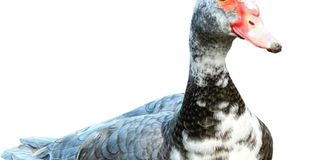Rearing ducks

I am interested in keeping ducks for both meat and eggs. Kindly advise me on accommodation, feeds, brooding, diseases and prevention and marketing. Dan Edimu
Dear Dan
Ducks can be reared in intensive, semi-intensive or free range systems. Under intensive system a floor space of 4 - 5 sq.ft./duck is essential, whereas in semi-intensive system, a floor space of 3 sq.ft./duck for the night shelter and 10 - 15 sq.ft. /duck as outside run would be adequate.
Under free range system, 1,000 ducks can be accommodated in 1 acre depending upon forage availability.
Water for swimming is not an essential feature however, continuous water flow channel with dimensions of about 20 inches wide by 6-8 inches deep should be constructed at one of the end of house.
This allows the birds to immerse their heads in the water to prevent scaly, crusty or in extreme cases blindness of eyes.
Brooding period takes three to four weeks and requires a temperature of 29 degrees celsius to 32 degrees celsius maintained during the first week and thereafter reduced by about 3 degrees celsius per week until it reaches 24 degrees celsius during the fourth week.
A hoover may be used to provide the supplemental heat, allow 0.10 sq.ft./duckling.
Pellets or combination of dry and wet mash is used for feeding. Wet mash feeding is preferred due to difficulty is swallowing of dry mash.
Therefore, ducks should not have access to feed without water. During the brooding period (0 – 8 weeks) the birds should always have access to feed by providing 50g to 110 gradually increased throughout this period.
Afterwards, feed may be offered only twice in a day-morning (8 am) and late afternoon (4-5 pm). From 9 weeks onwards feed consumption varies from 120-160g and above per bird per day, depending upon the rate of production, age and availability of greens.
Similar feeds as chicken may be used (layers feeds and broiler feeds), however, ducks have a higher protein requirement during the growing period while during the laying period its requirement is lesser than chicken.
Ducks are resistant to common poultry diseases. However, vaccination should be carried out for the duck cholera at 3 – 4 weeks and duck plague at 8 – 12 weeks as these tend to largely affect them.
Answered by Sophie Miyumo, Department of Animal Science, Egerton University.
I am interested in farming strawberry commercially. I need to know more on production per bush, vine or per plant per season, and the relation of the season to a year? Steven
Dear Steven
Strawberry farming is one of the most lucrative ventures and it can earn you a good income. Strawberry varieties include Chandler, which is the most popular among farmers and can be exported; Domanil, Pajaro Douglas, Tigio selva, Rabunda, Tri-star and Tribute, among other varieties.
Strawberry thrives in hot climates and does not do well in extremely cold areas. Depending on the variety, good agronomic practices such as using drip irrigation and mulching and use of farmyard manure should be employed. The crop takes 70 days to mature and harvesting continues twice a week.
The production can be between 30-80 kilogrammes of strawberry per week on a eighth acre.
Strawberry farming has good returns as it goes for Shs7,500 per kilogramme. One can harvest the crop for up to three years with good agronomic practices and a temperature of 10°C and 30°C and good type of soils including black cotton, loam and sand. It does not do well in clay soils.
Answered by Jayo Manyasi, department of Crops, Horticulture, and Soils, Egerton University.
My name is Alice, I am about to start keeping turkeys and my question is, is there a specific climate condition for keeping them, and what cage size do they require?
Dear Alice
Turkeys require a cool environment of room temperature ranging from 22–240c. The house space will vary from age to age; 1.5sq ft/bird at 0-4 weeks, 2.5sq ft/bird at 5-16 weeks, 4sq ft/bird at 16-29 weeks (ready for market) and 5sq ft for the breeding population.
The spacing per bird should be adequate for movement and staff as well as placement and access of feeders and drinkers.
Answered by Sophie Miyumo, Department of Animal Sciences, Egerton University.
I have been planting spinach for a while, but when it rains, they wilt when water splashes on them. Is there a way I can prevent this? Peter M
Dear Peter
Fungal diseases are easily spread through water splashes that carry the fungal spores to the healthy plant.
High incidences of spinach anthracnose are common in wet weather conditions.
It is recommended to practice crop rotation with non-host crops to reduce the pathogen load, or to spray fungicides during wet weather conditions to control the pathogen.
Answered by Sylvans Ochola a horticulture agronomist.
Compiled by Christine Katende
Send your questions to [email protected]




